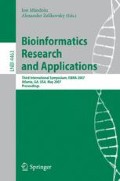Abstract
Neuropeptides are important signaling molecules that influence a wide variety of biological processes. The prediction of neuropeptides from precursor proteins is difficult due to the numerous and complex series of enzymatic processing and posttranslational modification steps. Bioinformatics prediction of cleavage sites using statistical models was used to overcome the challenge of identifying neuropeptides. Binary logistic models were trained on a bovine dataset and validated on a mammalian dataset that contained no bovine precursors. A model that incorporated amino acid locations and properties provided more accurate and precise cleavage predictions than one using amino acid locations alone. All models consistently resulted in highly accurate predictions of cleavage sites in both datasets. The logistic model proposed can accurately predict cleavage sites in mammalian species and minimize the time consuming and costly experimental validation of neuropeptides.
Access this chapter
Tax calculation will be finalised at checkout
Purchases are for personal use only
Preview
Unable to display preview. Download preview PDF.
References
Fricker, L.D.: Neuropeptide-processing enzymes: applications for drug discovery. AAPS J. 7, E449–455 (2005)
Hummon, A.B., et al.: From precursor to final peptides: a statistical sequence-based approach to predicting prohormone processing. J. Proteome Res. 2, 650–656 (2003)
Southey, B.R., Rodriguez-Zas, S.L., Sweedler, J.V.: Prediction of neuropeptide prohormone cleavages with application to RFamides. Peptides 27, 1087–1098 (2006)
Amare, A., et al.: Bridging neuropeptidomics and genomics with bioinformatics: prediction of mammalian neuropeptide prohormone processing. J. Proteome Res. 5, 1162–1167 (2006)
Southey, B.R., et al.: Prediction of neuropeptide cleavage sites in insects. Mol. Cell Proteomics (submitted) (2007)
Southey, B.R., et al.: NeuroPred: a tool to predict cleavage sites in neuropeptide precursors and provide the masses of the resulting peptides. Nucleic Acids Res. 34(Web Server issue), W267–272 (2006)
Schechter, I., Berger, A.: On the size of the active site in proteases. Biochem. Biophys. Res. Commun. 27(2), 157–162 (1967)
Berg, J.M., Tymoczko, J.L., Stryer, L.: Biochemistry, 5th edn. W.H. Freeman and Company, New York (2002)
Bendtsen, J.D., et al.: Improved prediction of signal peptides: SignalP 3.0. J. Mol. Biol. 340, 783–795 (2004)
Agresti, A.: An Introduction to Categorical Data Analysis. John Wiley and Sons, New York (1996)
Duckert, P., Brunak, S., Blom, N.: Prediction of proprotein convertase cleavage sites. Protein Eng. Des. Sel. 17, 107–112 (2004)
Baldi, P., et al.: Assessing the accuracy of prediction algorithms for classification: an overview. Bioinformatics 16, 412–424 (2000)
Matthews, B.W.: Comparison of predicted and observed secondary structure of T4 phage lysozyme. Biochim. Biophys. Acta 405, 442–451 (1975)
Ustach, C.V., Kim, H.R.C.: Platelet-derived growth factor D is activated by urokinase plasminogen activator in prostate carcinoma cells. Mol. Cell Biol. 25, 6279–6288 (2005)
Siegfried, G., et al.: Regulation of the stepwise proteolytic cleavage and secretion of PDGF-B by the proprotein convertases. Oncogene 24, 6925–6935 (2005)
Scamuffa, N., et al.: Proprotein convertases: lessons from knockouts. FASEB J 20, 1954–1963 (2006)
Hinuma, S., et al.: New neuropeptides containing carboxy-terminal RFamide and their receptor in mammals. Nat. Cell Biol. 2, 703–708 (2000)
Stein, J., Steiner, D.F., Dey, A.: Processing of cocaine- and amphetamine-regulated transcript (CART) precursor proteins by prohormone convertases (PCs) and its implications. Peptides 27, 1919–1925 (2006)
Author information
Authors and Affiliations
Editor information
Rights and permissions
Copyright information
© 2007 Springer-Verlag Berlin Heidelberg
About this paper
Cite this paper
Tegge, A.N., Rodriguez-Zas, S.L., Sweedler, J.V., Southey, B.R. (2007). Enhanced Prediction of Cleavage in Bovine Precursor Sequences. In: Măndoiu, I., Zelikovsky, A. (eds) Bioinformatics Research and Applications. ISBRA 2007. Lecture Notes in Computer Science(), vol 4463. Springer, Berlin, Heidelberg. https://doi.org/10.1007/978-3-540-72031-7_32
Download citation
DOI: https://doi.org/10.1007/978-3-540-72031-7_32
Publisher Name: Springer, Berlin, Heidelberg
Print ISBN: 978-3-540-72030-0
Online ISBN: 978-3-540-72031-7
eBook Packages: Computer ScienceComputer Science (R0)

